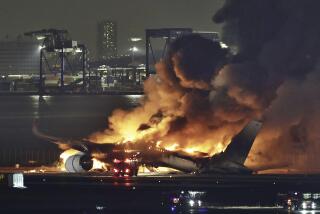Can’t Stop All Bomb Threats, Experts Say : Determined Terrorist, Plastic Explosives Can Evade Airport Security, They Report
- Share via
WASHINGTON — Amid growing speculation that an explosion caused the crash of Pan Am Flight 103, terrorism and aviation security experts said Thursday that the modern systems meant to ensure security of airports and airlines can do little to defend against a determined bomb-toting terrorist willing to die for his cause.
While the cause of the crash remains unknown, the suspicion of a terrorist attack clearly underscores the vulnerability of the world’s transportation system.
New, sophisticated plastic explosives easily can pass undetected through current airport security checks. And international rules requiring airlines to match all loaded baggage to a passenger are useless against terrorists willing to go down with the plane, experts noted.
‘Never Totally Confident’
“Even if security is stepped up to the maximum,” said Terrence Arnold, an expert on terrorism who is a consultant to the State Department, “100% security for a long period of time is very difficult to deliver. It’s just the mechanics of it.”
“We feel confident that we are doing as much as we can,” said Pamela Hanlon, a Pan Am spokesman. “But obviously, one never feels totally confident.”
If, indeed, terrorists are to blame in the Pan Am crash, they succeeded despite an alert from U.S. authorities to Pan Am and the Frankfurt airport, whose reputations for security are among the world’s best.
And if a bomb was the cause, it almost certainly was made from plastic explosives.
Such explosives, which U.S. officials have said are available to some terrorists through the Libyan government, are so powerful that a half-dollar-size chunk will blow up a freezer, and a suitcase-full will level an entire city block, said Neil Livingstone, an author and consultant on terrorism.
Virtually Undetectable
But they remain virtually undetectable by conventional security means, able to be formed into innocuous shapes, “rolled into sheets or crammed into a Walkman,” Livingstone said. On airport radar screens they show up only as a “dense type of substance.”
If a terrorist is intent on smuggling a plastic-explosive bomb directly through airport security checks, even the most watchful authorities “would have had a very difficult time” finding it, said Robert Kupperman, a State Department consultant. In this case, unless the government security alert brought about drastic security changes, a bomb might never even have been X-rayed if it had been packed in baggage bound for the belly of Flight 103, he said.
Experts noted that it might not even be necessary for a terrorist to board the plane, and face death himself, to get a bomb aboard. The international agreement requiring the matching of bags with individual passengers cannot prevent someone from planting explosives in the bags of what the industry calls a “naive traveler.”
At least three previous attempts at airborne bombing relied on plastic explosives, including an attack on a Pan Am jet out of Tokyo in 1983 and the bombing of an Athens-bound TWA plane in 1985, which blew a hole in the fuselage and sucked three passengers to their deaths.
Even more recently, plastic explosives were used in the attempt in 1985 to blow up a Tel Aviv-bound El Al airliner, which was foiled at the last minute by British authorities.
A bomb was believed responsible for the explosion of an Air-India jet over the Atlantic in 1985, in which 329 persons were killed, but the nature of the device was never determined.
Most security screening at airports now relies on metal detection, visual and X-ray inspection and, in some cases, assessment of passengers against likely terrorist “profiles.”
A more sophisticated security device able to “sniff” nitrogen vapors emitted by bombs, including plastic explosives, is being developed, largely with funding provided by Congress. But while its proponents insist that it is ready for service, no such machine is known to be in use. Industry sources said technical and financial problems remain to be worked out.
Meticulous Checks
Neither the Pan Am spokesman nor officials of the Federal Aviation Administration would disclose the nature of the extra precautions taken by Pan Am authorities after the alert, circulated by the FAA. But a knowledgeable security consultant said he understood that the airline’s added checks have been meticulous.
Other Pan Am officials said baggage being loaded in Frankfurt onto Flight 103, which used a Boeing 727 jet as far as London, was inspected electronically and put into containers. At Heathrow Airport in London, it was transferred in the containers to the hold of the larger Boeing 747 that crashed.
Passengers who set out from Frankfort on Flight 103 and changed planes in London were segregated from the general public in a transit lounge and so did not have to pass through security at Heathrow, they said.
Arnold, the consultant to the State Department, said that even if terrorists had succeeded against the heightened security in bringing the plane down, “one of the things we don’t know is how hard they tried.”
“The chances of succeeding with one trial are not very good,” he said. “But with a large airport, a large number of airplanes, and a large number of passengers--particularly at Christmas--sooner or later they’re going to get through.”
More to Read
Sign up for Essential California
The most important California stories and recommendations in your inbox every morning.
You may occasionally receive promotional content from the Los Angeles Times.













